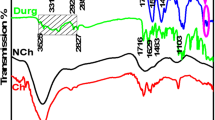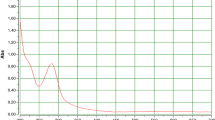Abstract
Copper nanoparticles localized on the surface of cotton fabric are synthesized. The structure and composition of the particles are determined by EXAFS, TEM, EPR, and XRF. The nanoparticles obtained are suggested to have a core shell structure. The study shows that copper is distributed in the fabric in the form of nanoparticles associated with fragments of macromolecules, on one hand, and in the form of nanoparticle conglomerates on the surfaces of the filaments of fibers, on the other hand. Modification of natural fabrics by copper nanoparticles results in complete destruction of Epidermophyton colonies and suppresses growth of Candida colonies, which makes it possible to apply such fabric in treatment of fungal diseases and in antiseptic treatment and healing of septic wounds.
Similar content being viewed by others
References
Sahithi, K., Swetha, M., Prabaharan, M., Moorthi, A., Saranya, N., Ramasamy, K., Srinivasan, N., Partridge, N.C. and Selvamurugan, N. Synthesis and characterization of nanoscale-hydroxyapatite-copper for antimicrobial activity towards bone tissue engineering applications, J. Biomed. Nanotechnol., 2010, vol. 6, pp. 333–341.
Kumar, R.V., Mastai, Y., Diamant, Y., and Gedanken, A., Sonochemical synthesis of amorphous Cu and nanocrystalline Cu2O embedded in a polyaniline matrix, J. Mater. Chem., 2001, vol. 11, pp. 1209–1213.
Bogoslovskaya, O.A., Sizova, E.A., Polyakova, V.S., Miroshnikov, S.A., Leipunskii, I.O., Ol’khovskaya, I.P., and Glushchenko, N.N., Study of safety of copper particles introduction with different physical-chemical characteristics in the organism of animals, Vestn. Orenburg. Gos. Univ., 2009, no. 2, pp. 124–127.
Qi, L.M., Ma, J.M., and Shen, J.L., Synthesis of copper nanoparticles in nonionic water-in-oil microemulsions, J. Colloid Interface Sci., 1997, vol. 186, pp. 498–500.
Park, B.K., Jeong, S., Kim, D., Moon, J., Lim, S., and Kim, J.S., Synthesis and size control of monodisperse copper nanoparticles by polyol method, J. Colloid Interface Sci., 2007, vol. 311, pp. 417–424.
Yurkov, G.Yu., Kozinkin, A.V., Nedoseikina, T.I., Shuvaev, A.T., Vlasenko, V.G., Gubin, S.P., and Kosobudskii, I.D., Copper nanoparticles in a polyethylene matrix, Inorg. Mater., 2001, vol. 37, pp. 997–1001.
Yurkov, G.Yu., Baranov, D.A., Kozinkin, A.V., Nedoseikina, T.I., Koksharov, Yu.A., and Gubin, S.P., Copper nanoparticles on the surface of ultradispersed polytetrafluoroethylene nanograins, Russ. J. Inorg. Chem., 2006, vol. 51, pp. 170–176.
Lee, Y., Choi, J.R., Lee, K.J., Stott, N.E., and Kim, D., Large-scale synthesis of copper nanoparticles by chemically controlled reduction for applications of inkjetprinted electronic, Nanotecnology, 2008, vol. 19, pp. 415–425.
Grouchko, M., Kamyshny, A., Ben-Ami, K., and Magdassi, S., Synthesis of copper nanoparticles catalyzed by pre-formed silver nanoparticles, J. Nanopart. Res., 2009, vol. 11, pp. 713–716.
Grace, M., Navin, Chand, N., and Bajpai, S.K., Copper alginate-cotton cellulose (CACC) fibers with excellent antibacterial properties, J. Eng. Fibers Fabrics, 2009, vol. 4, no. 3, pp. 24–35.
Kotel’nikova, N.E. and Mikhailidi, A.M., Modification of flax materials with copper particles, Khim. Rastit. Syr’ya, 2009, no. 3, pp. 43–48.
Zhang, W., Zhang, Y., Yan, J., Ji, Q., Huang, A., and Chu, P.K., Antimicrobial polyethylene with controlled copper release, J. Biomed. Mater. Res. A, 2007, vol. 83, pp. 838–849.
Cioffi, N., Ditaranto, N., Torsi, L., Picca, R.A., Giglio, E.De., Sabbatini, L., Novello, L., Tantillo, G., Bleve-Zacheo, T., and Zambonin, P.G., Synthesis, analytical characterization and bioactivity of Ag and Cu nanoparticles embedded in poly (vinyl methylketone) films, Anal. Bioanal. Chem., 2005, vol. 382, pp. 1912–1923.
Mirgorod, Yu.A., Postnikov, E.B., and Borshch, N.A., 13C NMR investigation of the structure of alkilammonium chloride micells in aqueous solutions, Russ. J. Struct. Chem., 2010, vol. 51, pp. 1111–1118.
Egorova, E.M., Nanoparticles of metals in solutions: Biochemical synthesis and application, Nanotekhnologii, 2004, no. 1, pp. 15–26.
Milanovskii, A.G. and Kats, M.B., RF Patent 2118174, 1998.
Efimov, K.M. and Kitajtsev, B.A., RF Patent 2372943, 2009.
Carrington, A. and McLachlan, A.D., Introduction to Magnetic Resonance with applications to Chemistry and Chemical Physics, 3rd ed., London: Chapman and Hall, 1979.
Al’tshuller, S.A. and Kozyrev, B.M., Elektronnyi paramagnitnyi rezonans soedinenii elementov promezhutochnykh grupp (Electronic Paramagnetic Resonance of Compounds of Elements of Intermediate Groups), Moscow: Nauka, 1972.
Abragam, A. and Blini, B., Electron Paramagnetic Resonance of Transition Ions, Oxford: Oxford Univ., 1970.
Wertz, J.E. and Bolton, J.R., Electron Spin Resonance. Tneory and Practical Applications, New York: McGraw-Hill, 1972.
de Jongh, L.J. and Miedema, A.R., Experiments on simple magnetic model systems, Adv. Phys., 1974, vol. 23, pp. 1–259.
Steiner, M., Villain, J., and Windsor, C.G., Theoretical and experimental studies on one-dimensional magnetic systems, Adv. Phys., 1976, vol. 25, pp. 87–209.
Carlin, R.L., Magnetochemistry Berlin: Springer-Verlag, 1986.
Maple, M.B., High-temperature superconductivity, J. Magn. Magn. Mater., 1998, vol. 177–181, pp. 18–30.
Domb, C. and Lebowitz, L.J., Phase Transitions and Critical Phenomena, New York: Academic, 1983, vol. 8.
Hendriksen, P.V. and Linderoth, S., Finite-size modifications of the magnetic properties of clusters, Phys. Rev. B: Condens. Matter, 1993, vol. 48, pp. 7259–7273.
Sato, S. and Ohshima, K., Antiferromagnetic transition temperature of MnO ultrafine particle, J. Phys. Soc. Jpn., 1995, vol. 64, pp. 944–950.
Sato, S., Ohshima, K., Sakai, M., and Bandow, S., Magnetic property of CoO ultrafine particle, Surf. Rev. Lett., 1996, vol. 3, pp. 109–113.
Gazeau, F., Shilov, V., Bacri, J.C., Dubois, E., Gendron, F., Perzynski, R., Raikher, Yu.L., and Stepanov, V.I., Magnetic resonance of nanoparticles in a ferrofluid: Evidence of thermofluctuational effects, J. Magn. Magn. Mater., 1999, vol. 202, pp. 535–546.
Kliava, J. and Berger, R., Size and shape distribution of magnetic nanoparticles in disordered systems: Computer simulations of superparamagnetic resonance spectra, J. Magn. Magn. Mater., 1999, vol. 205, pp. 328–342.
Winter, J., Magnetic Resonance in Metals, Oxford: Clarendon Press, 1971.
Mehran, F. and Anderson, P.W., The curious case of the Cu2+ electron paramagnetic resonance in high-Tc superconductors and related antiferromagnets, Solid State Commun., 1989, vol. 71, pp. 29–31.
Kindo, K., Honda, M., Kohashi, T., and Date, M., Electron spin resonance in cupric oxide, J. Phys. Soc. Jpn., 1990, vol. 59, pp. 2332–2335.
Shevchenko, O.V., Eidel’shtein, M.V., and Stepanova, M.N., Metallo-beta-lactamases: Importance and detection methods in gram-negative nonfermenting bacteria, Klin. Mikrobiol. Antimikrob. Khimioter., 2007, vol. 9, pp. 211–218.
Babushkina, I.V., Nanoparticles of metals in treatment of the experimental purulent wounds, Saratov. Nauchn.-Med. Zh., 2011, vol. 7, pp. 530–533.
Author information
Authors and Affiliations
Corresponding author
Additional information
Original Russian Text © M.I. Biryukova, G.Yu. Yurkov, S.A. Syrbu, N.A. Taratanov, 2013, published in Materialovedenie, 2013, No. 7, pp. 33–39.
Rights and permissions
About this article
Cite this article
Biryukova, M.I., Yurkov, G.Y., Syrbu, S.A. et al. Synthesis and structure of copper nanoparticles and their antiinfection properties. Inorg. Mater. Appl. Res. 5, 54–60 (2014). https://doi.org/10.1134/S2075113314010031
Received:
Published:
Issue Date:
DOI: https://doi.org/10.1134/S2075113314010031




